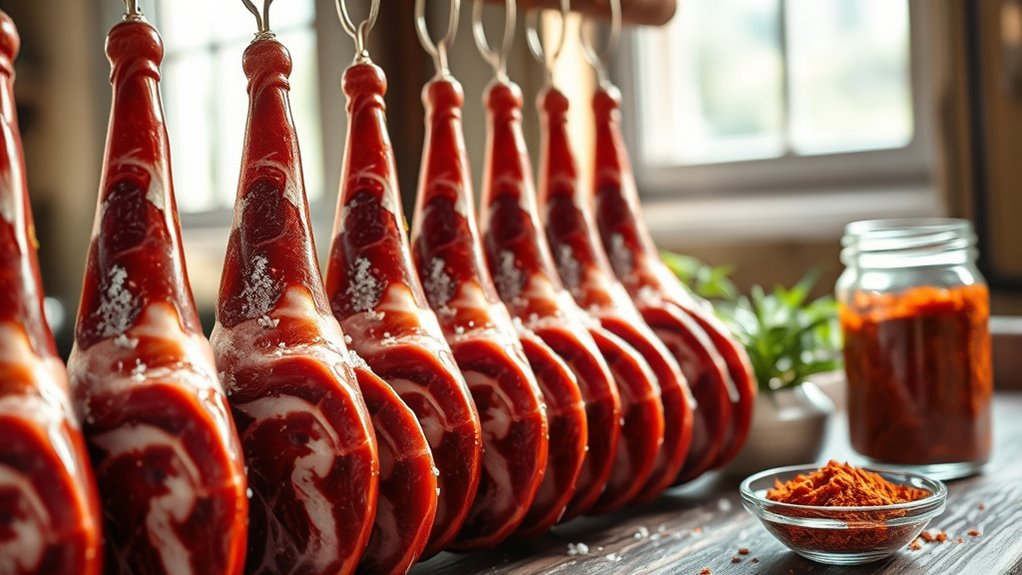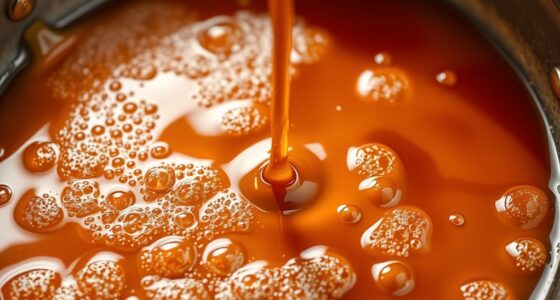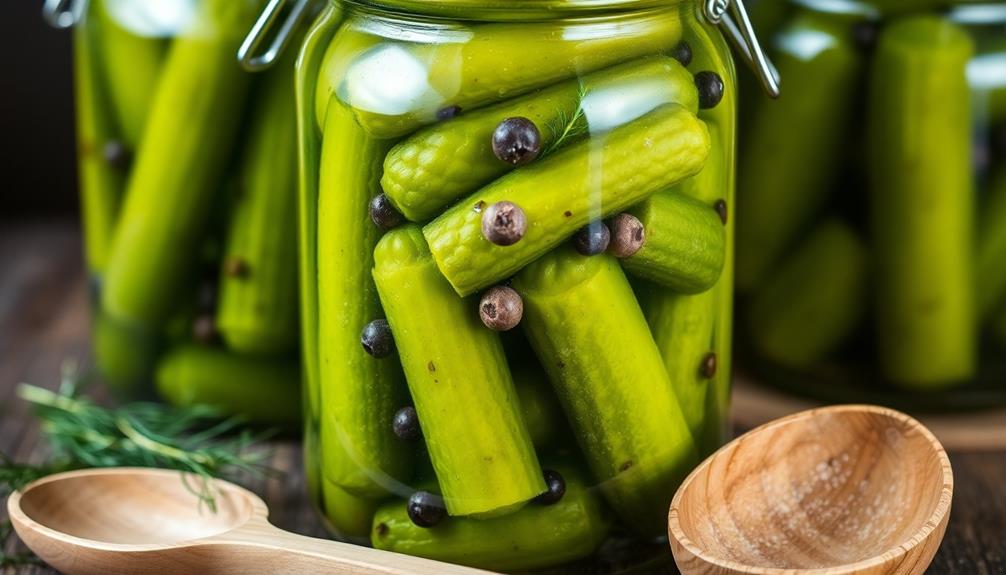Many believe nitrates are essential for safe meat curing, but science shows you can do it safely without them. By using proper salt, herbs, fermentation, and controlling temperature and humidity, you create an environment that inhibits harmful bacteria. Following established guidelines for curing times and hygiene supports safety without synthetic nitrates. If you want to understand how natural methods can be just as safe, there’s more to discover.
Key Takeaways
- Properly controlled fermentation and drying can safely preserve meat without nitrates when following established guidelines.
- Maintaining correct salt, sugar, and herbal ratios inhibits harmful bacteria naturally.
- Consistent temperature and humidity management promote beneficial microbes and prevent spoilage.
- Scientific evidence confirms that adherence to hygiene and curing protocols ensures safety without synthetic nitrates.
- Regular sensory checks and discard of suspect meat are essential for safe natural curing practices.

Curing meat without nitrates is possible and can be safe when you follow proper techniques and guidelines. Many people prefer natural curing methods because they avoid synthetic additives, but safety must always come first. When you opt for natural curing, you’re relying on methods like salt, sugar, herbs, and fermentation to preserve the meat. These techniques have been used for centuries and, when executed correctly, can produce delicious, safe products. However, understanding microbial safety is essential to prevent the growth of harmful bacteria, such as Clostridium botulinum or Listeria. Proper handling, precise timing, and correct ingredient ratios are necessary to guarantee that your cured meat remains safe to consume.
One of the key principles of natural curing is controlling moisture and pH levels in the meat. Salt draws out water, creating an environment where bacteria struggle to thrive. Sugar can act as a preservative and also enhance flavor. Herbs and spices not only add taste but sometimes have antimicrobial properties that support safety. Fermentation introduces beneficial bacteria that outcompete harmful ones, further stabilizing the meat. These methods, when combined and properly managed, form a natural barrier against microbial growth. But it’s essential to monitor conditions closely—temperature, humidity, and time—to prevent unintended fermentation or spoilage. Additionally, understanding the role of pH in microbial inhibition can help you optimize your curing process.
Many myths suggest that curing meat without nitrates is inherently unsafe, but science tells a different story. When you follow established guidelines—such as using the right amount of salt, maintaining correct temperatures, and curing for appropriate durations—you can considerably reduce risks. Scientific research supports natural curing as a viable alternative, provided you respect these parameters. For example, fermenting sausages at controlled temperatures promotes the growth of good bacteria, which inhibit pathogens. Similarly, drying meat in a controlled environment reduces moisture content, making it inhospitable to microbes. These practices align with food safety principles and can produce a product that’s both natural and safe. Furthermore, understanding microbial control strategies enhances your ability to prevent spoilage and ensure safety.
Following established guidelines ensures safe, natural meat curing without nitrates.
Ultimately, the key to safe non-nitrate curing lies in your attention to detail and adherence to proven techniques. Educate yourself on safe curing times, ingredient ratios, and storage conditions. Keep your workspace clean and practice good hygiene throughout the process. Regularly check your meat for signs of spoilage, and trust your senses—discard any product that looks or smells off. Additionally, understanding food safety principles and how they apply to natural curing can further reduce risks. Incorporating proper temperature control and humidity management is crucial for success. By combining traditional wisdom with scientific understanding, you can confidently pursue natural curing methods that preserve both the quality and safety of your meat.
Frequently Asked Questions
Can Homemade Curing Methods Match Commercial Nitrate-Based Processes?
You can’t exactly match commercial nitrate-based processes with homemade curing methods, but traditional preservation like salt curing can produce delicious, safe meats if done correctly. While salt curing alone doesn’t replicate the color and safety nitrates provide, proper techniques and hygiene are essential. By understanding the science behind curing, you can create flavorful, safe meats at home, but it’s important to follow trusted recipes and guidelines carefully.
Are There Specific Meats Better Suited for Nitrate-Free Curing?
When choosing meats for nitrate-free curing, focus on meat selection and curing suitability. You’ll find that lean cuts like pork loin or beef brisket work well because they cure evenly and develop rich flavors without nitrates. Avoid very fatty or thin meats, which may not cure properly or could spoil faster. Select fresh, high-quality meats and follow precise curing techniques to guarantee safety and delicious results without nitrates.
How Long Does Nitrate-Free Curing Typically Take?
Imagine a slow dance, where patience leads the way. Nitrate-free curing typically takes longer, with a curing duration that can range from several days to weeks, depending on the meat and the method. The nitrate-free timeline is more flexible, relying on salt, sugar, and natural preservatives to work their magic. You’ll notice the flavors deepen and textures develop gradually, rewarding your patience with a rich, wholesome taste.
What Are Signs of Spoilage in Nitrate-Free Cured Meats?
When checking nitrate-free cured meats for spoilage, look for clear detection indicators and spoilage markers. You might notice a sour or off smell, slimy surface, or discoloration, such as gray or green patches. These signs suggest bacteria growth or fermentation. Trust your senses—if the meat seems unusual in appearance, smell, or texture, it’s safest to avoid consumption, as these are common spoilage markers indicating it’s no longer safe to eat.
Is There a Significant Taste Difference Without Nitrates?
Imagine tasting a nitrate-free ham and noticing subtle flavor nuances that differ from conventional curing. Without nitrates, you might experience slight texture variations and a milder, fresher taste. While some say there’s no significant taste difference, others find the flavor profile more delicate and natural. Your palate could pick up on these nuances, making the meat feel more authentic, though the overall experience remains quite similar.
Conclusion
So, if you want to cure meat safely without nitrates, stick to the science, use proper hygiene, and keep your kitchen as clean as a Victorian apothecary. Don’t fall for myths or shortcuts—trust proven methods, like salt and natural preservatives, just like your ancestors did. Remember, even in this modern age, curing meat remains a delicate art that demands respect and care. Keep it safe, and your cured meats will be as legendary as a knight’s feast.










